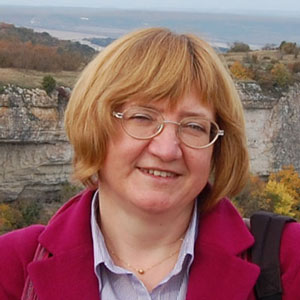Dr hab. Anna Bitner-Wróblewska
 Państwowe Muzeum Archeologiczne
Państwowe Muzeum Archeologiczne
ul. Długa 52 – Arsenał
PL-00-241 Warsaw
a.bitner@pma.pl; abitnerwroblewska@gmail.com
I graduated from the University of Warsaw, Institute of Archaeology. Currently I am Qualified Curator of the State Archaeological Museum in Warsaw, head of the Department of Balt Archaeology. I was keeper and co-author of several archaeological exhibitions (“Prusowie. Dzieje i kultura ludu bałtyjskiego”/Prussians. The history and culture of the Balt people, “Sztuka Bałtów. Baltų menas”/Art of the Balts). I conducted archaeological excavation and surface surveys in Masuria and the Suwałki region (e.g., at Kazimierówka, Ławki, Paprotki, in the valley of the Marycha river). My main areas of research interest include prehistory and protohistory of Balt peoples during the Roman Period and the Migrations Period, first of all, their contacts with Scandinavia and Finnish territory, as well as their exchange with Wielbark Culture and Przeworsk Culture communities.
Another area of my activity is the study of archival sources related to Balt archaeology and reconstructing the archaeological heritage of former East Prussia. Since 2008 I have been taking part in the international project Ostbalticum (see homepage of Polish Ministry of Culture and National Heritage). In 2005-2008, I was co-organizer of the Polish-Danish project: “Archaeology and heritage culture. Contacts across the Baltic Sea during the Iron Age”. I initiated the “Project Szurpiły” aimed on post-excavation analysis of input from past and new investigation of one of the key settlement centres of Yatvingia.
I have published over 80 articles and two monographs, and am co-author of two other books. I was editor or co-editor of 10 books. I am a member of editorial boards of two Lithuanian and one Latvian periodical.
Last, but not least, I am co-organizer of the Balt Seminar, founding member of Kommission zur Erforschung von Sammlungen Archäologischer Funde und Unterlagen aus dem nordöstlichen Mitteleuropa (KAFU), and honorary member of the Society of Lithuanian Archaeology.
Selected publications related to the project
- Zapinki z gwiaździstą i łopatkowatą nóżką z południowo-wschodnich wybrzeży Bałtyku, „Wiadomości Archeologiczne”, LI/1 1991 (1986-1990), s. 49-90.
- Between Scania and Samland. From Studies of Stylistic links in the Baltic Basin during the Early Migration Period, „Fornvännen” 86, 1991, s. 225-241.
- Z badań nad ceramiką zachodniobałtyjską w okresie wędrówek ludów. Problem tzw. kultury sudowskiej, Barbaricum 3, Warszawa 1994, s. 219-241.
- Long Distance – Close Connections. Norway and the Balt Lands during Migration Period, „Universitetets Oldsaksammling Årbok 1993/1994”, Oslo 1995, s. 171-189.
- Early Migration Period in the Mazurian Lakeland - Phantom or Reality?, (w:) M. Mączyńska, T. Grabarczyk (red.) Die spätrömische Kaiserzeit und die frühe Völkerwanderungszeit in Mittel- und Osteuropa, Łódź 2000, s. 153-167.
- 6. Das „verlorene” Gräberfeld von Anduln, Memelgebiet (derzeit Ėgliškiai-Anduliai, West-Litauen). Ein Wiedergewinungsversuch, „Acta Archaeologica et Praehistorica” 35 2004 (2003), s. 185-210 (współautorzy A. Bliujienė, W. Wróblewski).
- 7. From Samland to Rogaland. East-West connections in the Baltic basin during the Early Migration Period, Warszawa 2001.
- 8. From Aestii to Esti. Connections between the Western Lithuanian Group and the area of distribution of Tarand-Graves (współautor R. Banytė-Rowell), (w:) V. Lang (red.), Interarchaeologia, 1. Papers from the first theoretical seminar of the Baltic archaeologists (BASE) held at the University of Tartu, Estonia, October 17th-19th 2003. Culture and material culture, Tartu-Riga-Vilnius 2005, s. 105-120.
- 9. Sösdala und Sösdala style, (w:) Reallexikon der Germanischen Altertumskunde 29, Berlin-New York 2005, s. 211-213.
- The key problems of late Migration Period in the Balt lands, (w:) M. Bertašius (red.) Transformatio mundi. The transition from the Late Migration Period to the Early Viking Age in the East Baltic, s. Kaunas 2006, s. 7-15.
- Zmierzch kultury bogaczewskiej i jej relacje z grupą olsztyńską, (w:) A. Bitner- Wróblewska (red.), Kultura bogaczewska w20 lat później. Materiały z konferencji, 26-27 marca 2003, Warszawa, Seminarium Bałtyjskie I, Warszawa 2007, s. 219-237.
- Netta. A Balt Cemetery in Northeastern Poland, Monumenta Archaeologica Barbarica XII, Warszawa 2007.
- Observers or participants? The Balts during turbulent epoch, (w:) B. Niezabitowska- Wiśniewska, M. Juściński, P. Łuczkiewicz, S. Sadowski (red.), The turbulent epoch. New materials from the Late Roman Period and the Migration Period, t. I, Monumenta Studia Gothica V, Lublin 2009, s. 97-112.
- Die Periodisierung der Gräberfelder von Tumiany (Daumen) und Kielary (Kellaren). Ein Beitrag zur Diskussion über den Ursprung der Olsztyn-Gruppe, (w:) A. Bitner-Wróblewska, C. von Carnap-Bornheim, J. Ciglis, V. Hilberg, W. Nowakowski (red.), F. Jakobson, Die Brandgräberfelder von Daumen und Kellaren im Kreise Allenstein, Ostpr. Daumen und Kellaren – Tumiany i Kielary, t. 1, Schriften des Archäologischen Landesmuseums 9, Neumünster 2009, s. 397-414.
- Badania technologiczne wschodnioeuropejskich zabytków zdobionych emalią (współautor T. Stawiarska), (w:) A. Bitner-Wróblewska, G. Iwanowska (red.), Bałtowie i ich sąsiedzi. Marian Kaczyński in memoriam, Seminarium Bałtyjskie II, Warszawa 2009, s. 303-351.
- North-eastern Poland in first centuries AD – a world apart, (w:) U. Lund Hansen, A. Bitner-Wróblewska (red.), Worlds apart? Contacts cross the Baltic Sea in the Iron Age. Network Denmark-Poland, 2005-2008, Nordiske Fortidsminder, Serie C, vol. 7, København-Warszawa 2010, s. 141-184.
- East European Enamelled Ornaments and the Character of Contacts between the Baltic Sea and the Black Sea, (w:) I. Khrapunov, F.-A. Stylegar (red.) Inter Ambo Maria. Contacts between Scandinavia and the Crimea in the Roman Period, Simferopol, 2011, s. 11-24.
- Zapinki podkowiaste w grupie olsztyńskiej – tropem archiwum Feliksa Jakobsona. Hufeisenfibeln in der Olsztyn-Gruppe – auf der Spur des Archivs von Felix Jakobson. Olštinas Grupas kapulaukos trastās pakavsaktas – pētījumi Fēliksa Jākobsona arhīvā, T. Nowakiewicz (red.), Archeologiczne dziedzictwo Prus Wschodnich w archiwum Feliksa Jakobsona. Das archäologische Vermächtnis Ostpreußens im Archiv des Felix Jakobson. Austrumprūsijas arheoloģiskais mantojums Fēliksa Jākobsona arhīvā, Aestiorum Hereditas, tom II, Warszawa 2011, s. 548-561.
- Did they exist? The question of elites in Western Lithuania in the Roman and Early Migration Period and their inter-regional contacts (współautor R. Banytė-Rowell, Ch. Reich), Archaeologia Baltica, Klaipėda. (w druku).


